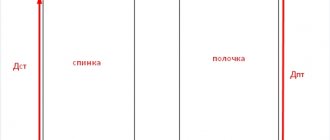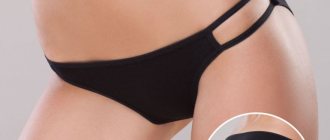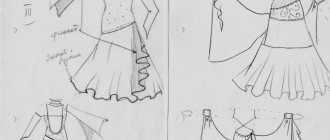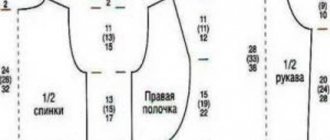The pattern of men's family underpants is not as simple as it might seem, especially underpants for overweight men, starting from size 56. Incorrect calculations will lead to the fact that the panties will be uncomfortable, the threads in the seams will break, despite the fact that the panties seem to be loose.
DIY women's knitted shorts. Subscribe to my channel and you will learn how to sew various clothes.
The pattern for men's briefs is practically the upper part of men's trousers, so to make an accurate pattern you will have to do a little calculation and possibly adjust something during the fitting. But then, based on these calculations, you will be able to make a good pattern and use it constantly not only for patterning panties, but also for cutting light summer shorts with an elastic band. It is most convenient to create a pattern on graph paper.
Men's family pants should be comfortable, hygienic, practical, and therefore the fabrics for sewing men's pants should be soft, light and thin, but at the same time be durable and have a stable color. It is best to use chintz, satin or lightweight calico, 90 and 150 cm wide, for sewing panties.
Flower nursery Green Gate
Do you like indoor or garden flowers? At the Green Gate nursery you can buy rooted cuttings and divisions of various domestic and perennial garden flowers. We have a constantly updated collection of anthuriums and hibiscus. Flowers and plants are sent by mail.
Technology for sewing a baseball cap, from pattern to clasp. Subscribe to my channel and you will learn a lot of useful sewing tips from a professional.
What measurements are needed for men's briefs?
We offer a pattern for men's family briefs, made with short shorts without inserts. To construct a drawing of a pattern for men's underpants, the following measurements were used: St = 41 cm, Sat = 50 cm, Oh trouble. = 55 cm. For example, measurements taken: 176-96-82. St is half waist circumference. Sb - semi-circumference of the hips (at the widest point of the buttocks). Dinner. - thigh circumference at the highest point. To prevent the finished product from being too tight, allowances for a loose fit are used when creating patterns. Increases for men's underpants: Pb tall. = 2 - 5cm, Pb bad. = 5 - 6cm. For this size, we will choose an increase of 2 cm at the waist and 6 cm at the hips.
If you don't know how to take men's measurements correctly, see How to take measurements.
Pattern for men's family briefs without a side seam
This pattern was taken from an old Soviet-era textbook; we have nothing to do with the authorship of this design. But among many other options, it seemed quite decent to us, as we were later convinced of. Below we provide a brief description of the construction of the drawing. It doesn't have to be built on paper. If you have enough experience, you can create a panty pattern directly on the fabric (see below).
Measurements taken as an example: H (half waist circumference) - 40 cm. Sat (half hip circumference) - 50cm. Di (product length) - 34cm (can be changed as desired). PB (increase along the hip line) - 3 cm. Depending on the degree of fit of the panties to the body, the increase in the hips can vary from 2 to 8 cm.
Constructing a pattern for men's underpants
The pattern begins by drawing a vertical line on a sheet of graph paper with the apex at point A. 1. From point A down, set the seat height: AH = 0.5 C6 + 1 = 0.5 X 50 + 1 = 26 cm and determine the length of the panties ( without allowances) according to the formula: AN2 = AN + 7 (increase) = 26 + 7 = 33cm. Both of these values are recommended for the second half (back), so you can immediately build the pattern and the second ladles. But we will give calculations sequentially, first for the front of the panties, then for the back.
How to cut a product
To make cutting the material easier, it would be better to transfer the resulting drawing of both halves of the product onto a large sheet of cardboard or plastic film, not forgetting to leave room for allowances. To make it more convenient, all dimensions are usually written in centimeters.
Thus, it will be easier to lay out the prepared fabric according to the resulting underwear patterns. Also, the workpiece will not let you forget about making seam allowances.
Preparing the pattern
To avoid having to redo the pattern later, it is recommended to first sew a test pair of panties from the draft and determine whether any changes in size are needed. If everything fits well, then the drawing is transferred to cardboard or film. Then such patterns can be used to make large quantities of underwear.
It will be more convenient to cut the front and back parts entirely. To do this, the halves of each side are placed next to each other along the edge and stitched. Thus, you will get not four parts, but only two.
The front half of the panty pattern
2. From points A, H, H2, set aside the measurement Sb (half hip circumference) with an increase of 1 cm, for a total of 26 cm. Designate new points A1, H1, H3.
3. From point H1, set aside 1/6 of the half-circumference of your hips to the right (50/6 = 8.3 cm). Do not take into account tenths of calculations (and further too), let it be 8.5 cm.
4. Now you need to find point B1. To do this, divide the hip circumference measurement by 6 and subtract 1.8 cm. The total will be approximately 6.5 cm.
5. Connect this segment with a straight line, setting aside 1 cm from points B1 and B.
6. Next, set aside 1 cm from point A1 and connect this new point to point A, as shown in the diagram.
7. Set aside 1/2 of the half-waist measurements on this line plus an increase of 3 cm, and place a point T, where AT = (41: 2) + 3 = 23.5 cm.
8. Now all that remains is to set aside a 4.5 cm long segment dividing the angle A1H1B in half and draw the line of the front seam with a smooth concave curve.
Construction
1. Draw a vertical on the left side of the sheet with the vertex at the point 0
2. Down from point 0 , set the value of the seat height +3cm (24+3=27) and set point 1
3. To the right of point 0 , set aside the value 1/4Rev (83.3/4=20.8) – point 2
4. Put 1.5 cm up from point 1 and put point 3 , then put another 1 cm up from the resulting point and put point 4
5. To the left of point 2, set aside 1 cm and place point 5 , down from point 2 , set aside 6 cm and place point 6 . Connect points 5 and 6 with a straight line (this is the side seam of the panties)
6. From point 0, step down 1.5 cm - point 7 . Connect points 7 and 5 with a smooth concave line, as shown in the drawing.
7. Up from point 0, set aside 3-3.5 cm and draw a belt parallel to the line 0-2
8. Move 6 cm up from point 1 - point 8 , and move 2 cm 1 9 . Connect points 8 and 9 with a straight line and continue it down another 2 cm, put point 10
9. To the right of point 1 , set aside 5.5 cm, place point 11 and connect it with an auxiliary line to point 6 . Divide segment 6-11 in half and at a right angle to the segment, set aside 1 cm to the right - point 12 . Draw a cutout for the leg of the back piece with a smooth line through points 11-12-6 as shown in the figure.
10. From point 3 to the right, draw a horizontal line until it intersects with the smooth line of the cutout for the legs and place point 13 . Points 13 and 4 are also connected with a smooth line. This is the gusset seam line on the back piece.
11. Copy the section highlighted in pink (translate it onto tracing paper and cut it out), turn it over with a straight cut up and attach it to an inclined line, as shown in the figure. Points 10 and 1 should converge in one place. I highlighted in orange and duplicated the points on the drawing ( 1* - 4* - 11* - 13* )
12. From the middle of the auxiliary line for cutting out the leg, draw a perpendicular into the drawing 5-6 cm long (I drew 5.5) - point 14 . Draw a smooth cutout line for the legs of the front piece connecting points 11*-14-6.
13. From point 14 , draw a horizontal line to the left until it intersects with the mid-front line. Place point 15 and extend this line to the left by 0.7 cm - point 16 . Draw a smooth line in the middle of the front through points 7-16-8-4*
14. From point 7 to the right, set aside 4.5 cm and put point 17 , connect points 7 and 17 with a straight line.
The drawing is constructed without seam allowances.
It is necessary to transfer to tracing paper: the front insert, the side part of the front, the back of the panties. Apply seam allowances and cut out one folded back piece, two side pieces and 4 front panel pieces. You also need to cut out a belt with a fold, or make a one-piece belt, as I did.
And for those who are familiar with the Valentina program, I recorded a video on how to build and model this pattern there. The pattern is parametric and you just need to enter other measurements so that the drawing is automatically adjusted to the desired size
Back half of the panty pattern
9. Horizontal segments AA1, HH1, H5H4 are equal to 1/2 of the half-hip measurement plus 6 cm, that is (50: 2) + 6 = 31 cm.
10. From point H to the left, set aside a segment of 2 cm and place a point (2).
11. From point H5, continue a straight line to the left by 1/4 of the hip circumference measurement minus 1 cm and place point B2. Н5Б2 = (50: 4) - 1 = 11.5 cm.
12. From point H5, continue down a vertical line 3 cm and place point H6. From point H6, move 1/4 of the thigh circumference minus 1.5 cm to the left horizontally and place point B3. Н6Б3 = (55: 4) - 1.5 = 12 cm.
13. Draw a straight line through points B2 and B3, extending it upward beyond point B2 by 1 cm. You also need to set aside a segment from point B3, but you can determine its value only by measuring the same section of the front half of the panties. Or simply place the front piece pattern on this line and make a mark.
14. Now all that remains is to adjust the waist line and draw a smooth line for the back seam. From point A1, move 1/2 of the waist semicircle plus 5 cm to the left horizontally and place point T1. A1T1 = (41: 2) + 5 = 25.5 cm. Next, from point T1, set aside 2 cm vertically and place point T2. Connect points T2 and A1 with a straight line.
Constructing a pattern
Front half
- The construction of a pattern for family panties begins with drawing a rectangle TNN1T1. Its horizontal sides are equal to the value of the sum of the semi-circumference of the hips (SB) and the increase (PB). For example: 50 cm + 3 cm = 53 cm. The vertical side of the rectangle is determined by the length of the product - 34 cm.
- Each horizontal side must be divided in the middle and the resulting points must be marked with the letters B and B1, respectively.
- Points Ш and Ш1 are very important for creating the correct drawing. Their location is calculated by the formula: ТШ (Т1Ш1) = 0.5 (SB + PB) = 25 + 3 = 28 cm.
- Next, using another formula, you need to calculate the length of the segment Ш1Ш2 = СБ/8 + 1 = 6.3 +1.0 = 7.3 cm. Jewelry precision is not required when creating a pattern of loose family panties
.
Therefore, the calculated values can be safely rounded to tenths. In this case - up to 7.5 cm. - Then you need to construct point Ш3, the position of which is calculated by the formula: ШШ3 = 0.25 x Sb - 1.0 = 11.5 cm.
- Next is the turn of constructing the waist line. The segment T1SH1 needs to be divided into three equal sections. From T1, retreat 1 cm down and to the left, place point T2. Draw a curved line through B and T2 (you can use a pattern).
- After this, you need to draw another smooth line T2SH2.
- Then the line T1H1 should be extended 2 cm downwards, mark the point H2, and draw the segment Ш2Н2.
- Then you need to smoothly draw a line B1H2.
This completes the construction of the pattern for the front half of the panties.
Rear half
- On the left side of the drawing, you need to divide the segment Ш3Ш in half and mark the middle with the point Ш4.
- Next, you should step back 1 cm from Ш3 and mark point Ш5.
- After this, you need to calculate the location of the waist line. From T it is necessary to set aside 2 cm to the right and mark point T3.
- Next, you should draw a straight line Ш4Т3 so that T3 is 5 cm below point T4. The resulting section (Ш4Т4) should be divided into three equal parts.
- Next, with a smooth line you need to connect pairs of points Sh5 and D4, T4 and B, respectively.
- After this, it is necessary to set aside 5 cm from point H to the left and place point H4 according to this formula: HH4 = 0.1 x SB = 0.1 x 50 = 5 cm.
- Section H2Sh2 needs to be measured, the resulting value is set aside from point Sh5 through H4 and mark point H6. Next, H6 and B1 should be carefully connected with a curved line.
That's it, the drawing is completed!
The prepared pattern for family panties is very simple and convenient. There are no side seams, which simplifies the further assembly process.
Important! If you need a large size product (from 56), then a side seam is necessary for a better fit.
This is interesting: Men's sweatshirt pattern
How to cut men's family briefs
To make it more convenient for you to cut the fabric, transfer the drawings of the front and back halves of the pattern for men's underwear to another sheet of cardboard or oilcloth along with the allowances. Allowances in the drawing are indicated in centimeters. It will be convenient for you to use the resulting panty patterns with allowances when laying out the fabric. At the same time, with such a pattern you will not forget to make seam allowances.
The patterns may have to be adjusted in the future, so it is better to sew test panties, make sure that the pattern is accurate, and then transfer it to cardboard or oilcloth. Such patterns are convenient to use when cutting and laying out fabric.
The front and back of the panties can be cut entirely. To do this, simply align the side seams of these halves together, then instead of four parts you only have two.
Sewing process
It is not difficult to sew the product itself using a pattern for men's briefs in size 52. The DIY sewing algorithm involves performing the following steps:
- Before you start sewing panties, transfer the created pattern from paper to fabric. To do this, lay it out on a straight surface and attach the paper to the fabric with pins.
- Then make a seam allowance of 1.5 cm.
- The allowance along the waist line should be 3 cm. This is necessary to insert the elastic.
- Cut out the fabric according to the prepared sketches.
- Baste the product, and then sew the stitch, leaving 1.5 cm on the middle seam, making an incision on it.
- Then sew all the allowances using a zigzag machine stitch.
- Treat the bottom of the panties and then iron.
- Insert the rubber band.
Sewing family panties with your own hands is a feasible task for every person. And the step-by-step instructions on how to sew men's family briefs will help you cope with the task with ease. What will you need? Pattern, time and desire. And then you can make family pants or boxers yourself, surprising and delighting your spouse with your talents.
Originally posted 2018-08-29 09:08:48.
Layout of panty pattern details on fabric
When laying out the patterns of the front and back halves of the panties on the fabric, it is necessary to observe the direction of the grain thread on the patterns and fabric. The directions of the grain thread for different fabric widths are indicated by arrows.
Note the fold line of the fabric for each width of fabric. With a fabric width of 85-90 cm, fold the fabric in half along the grain (lengthwise). In this case, for pant size 176-96-82 you need 1.04 meters of fabric.
With a fabric width of 140 cm, fold the fabric along the weft thread (across the fabric). In this case, the fabric consumption for men's briefs size 176-96-82 will be 0.52 m.
If you need to sew men's briefs in a large size, for example, size 56 or more, then the pattern of men's briefs must be made with an insert for the back half. The layout of the panties will have to be slightly changed and an additional wedge added to it.
Preparing for work
Sewing men's underpants is not a difficult task. The most time-consuming part of the work will be creating the pattern. Beginning needlewomen are recommended to master the technique using the example of a simple pattern of panties without a side seam and gusset. The absence of side stitching allows not only to reduce fabric consumption, but also to eliminate some operations with cutting, thereby reducing work time.
You can sew men's briefs from any natural fabric, for example, chintz or fine knitwear. You will also need threads to match the color of the material, an elastic band and tailor's tools.
Beginner seamstresses are recommended to create a pattern on paper and then transfer it to fabric. Experienced needlewomen can design a pattern directly on a piece of material.
To work, you will need some measurements that should be taken from the “model”:
- Half waist measurement. Symbol - ST. In the proposed example, this measurement is 40 cm.
- Half hip circumference. Designation - SB. In the above diagram, half the hip circumference is 50 cm.
- The length of the product (DI) can be selected individually or use the standard one - 34 cm.
An increase of 3 cm should be made along the hip line. Designation - PB. It is also important to determine the degree of fit of the product to the body. That is, from 2 to 8 cm should be added to the SB.
If it is not possible to take measurements, for example, when preparing a surprise, you can determine the measurements using the existing panties. You can cut comfortable and original boxers by taking measurements from shorts and reducing them to the desired size.
How to sew men's underpants
If you have at least a little experience in sewing bed linen, then sewing panties will not be a problem for you. Why bed linen? Because the connecting seams need to be “packed” with a linen seam. This is necessary because underwear has to be washed constantly and the cut edges of cotton fabric treated in a different way will fray.
Instead of a linen seam, you can stitch the seams and process them with an overlocker, but not with a zigzag stitch. There is no need to add a finishing stitch; unnecessary needle punctures will only destroy the fibers of the cotton fabric.
The lower sections of the panties are sewn with a hem seam (0.7 - 1.0), and the upper section (for the elastic) with a wide hem, 2 cm wide.
In this video you will learn the sequence of sewing women's or children's shorts from knitted fabric.











